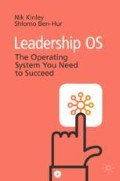Abstract
In this chapter, the authors introduce the concept of a Leadership Operating System (OS) as the main mechanism through which leaders drive performance. They begin by describing a fundamental challenge faced by all traditional leadership competency models, namely that they ignore the role context plays in determining the impact of competencies. They then introduce research showing that as leaders become more senior, their impact on the business’ performance becomes more indirect—achieved not through directly driving certain behaviours in others, but by creating an operating environment that enables and supports certain behaviours in others. Finally, they describe their research revealing the three key elements these operating environments are comprised of and introduce a model capturing these elements.
Access this chapter
Tax calculation will be finalised at checkout
Purchases are for personal use only
References
B. Bass, “From transactional to transformational leadership: Learning to share the vision,” Organizational Dynamics, vol. 18, no. 3, pp. 19–31, 1990.
D. Wyld, “Transformation leadership: When is it redundant?,” Academy of Management Perspectives, vol. 27, no. 2, https://doi.org/10.5465/amp.2013.0064, 2013.
O. T. C., A. Okwu, V. Akpa and I. Nwankwere, “Effects of leadership style on organizational performance: A survey of selected small scale enterprises in ikosi-ketu council development area of lagos state, Nigeria,” Australian Journal of Business and Management Research, vol. 1, no. 7, pp. 100–111, 2011.
C. Robert, T. Probst, J. Martocchio, F. Drasgow and J. Lawler, “Empowerment was negatively associated with work and co-worker satisfaction in India but positively associated with supervisor satisfaction in the United States,” Journal of Applied Psychology, vol. 85, no. 5, pp. 643–658, 2000.
S. Eisenbeiss and S. Boerner, “A double-edged sword: Transformational leadership and individual creativity,” British Journal of Management, vol. 24, pp. 54–68, 2013.
N. S. Hill and K. M. Bartol, “Empowering leadership and effective collaboration in geographically dispersed teams,” Personnel Psychology, vol. 69, pp. 159–198, 2016.
J. Barling, The science of leadership: Lessons from research for organizational leaders, New York, NY: Oxford University Press, 2014.
P. Hersey and K. H. Blanchard, Management of organizational behavior 3rd Edition—Utilizing human resources, Upper Saddle River, NJ: Prentice Hall, 1977.
F. Dansereau, G. Graen and W. J. Haga, “A vertical dyad linkage approach to leadership in formal organizations,” Organizational Behavior and Human Performance, vol. 13, no. 1, pp. 46–78, 1975.
K. Dirks and D. Ferrin, “Trust in leadership: Meta-analytic findings and implications for research and practice,” Journal of Applied Psychology, vol. 87, no. 4, pp. 611–628, 2002.
K. Dirks, “Trust in leadership and team performance: Evidence from NCAA basketball,” Journal of Applied Psychology, vol. 85, pp. 1004–1012, 2000.
J. H. Davis, F. D. Schoorman, R. C. Mayer and H. H. Tan, “The trusted general manager and business unit performance: Empirical evidence of a competitive advantage,” Strategic Management Journal, vol. 21, pp. 563–576, 2000.
R. Martin, Y. Guillaume, G. Thomas, A. Lee and O. Epitropaki, “Leader–Member Exchange (LMX) and performance: A meta-analytic review,” Personnel Psychology, vol. 69, pp. 67–121, 2015.
N. Gillespie and L. Mann, “Transformational leadership and shared values: The building blocks of trust,” Journal of Managerial Psychology, vol. 19, no. 6, pp. 588–607, 2004.
R. Stagner, “Corporate decision making: An empirical study,” Journal of Applied Psychology, vol. 53, no. 1, pp. 1–13, 1969.
K. Dale and M. L. Fox, “Leadership style and organizational commitment: Mediating effect of role stress,” Journal of Managerial Issues, pp. 109–130, 2008.
M. W. Johnston, A. Parasuraman, C. M. Futrell and W. C. Black, “A longitudinal assessment of the impact of selected organizational influences on salespeople’s organizational commitment during early employment,” Journal of Marketing Research, vol. 27, no. 3, 1990.
S. Giles, “The most important leadership competencies, according to leaders around the world,” Harvard Business Review, 15 March 2016.
S. Hannah, M. Uhl-Bien, B. Avolio and F. Cavarretta, “A framework for examining leadership in extreme contexts,” University of Nebraska Management Department Faculty Publications. Paper 39, 2009.
F. Walumbwa, B. Avolio and W. Zhu, “How transformational leadership weaves its influence on individual job performance: The role of identification and efficacy beliefs,” Personnel Psychology, vol. 61, no. 4, pp. 793–825, 2008.
S. Hannah, B. Avolio, F. Walumbwa and A. Chan, “Leader self and means efficacy: A multi-component approach,” Organizational Behavior and Human Decision Processes, vol. 118, no. 2, pp. 143–161, 2012.
D. H. Schunk and P. A. Ertmer, “Self-regulation and academic learning: Self-efficacy enhancing interventions,” in M. Boekaerts, P. R. Pintrich, & M. Zeidner (Eds.), Handbook of self-regulation, San Diego, CA, Academic Press, 2000, pp. 631–649.
M. E. Gist, C. K. Stevens and A. G. Bavetta, “Effects of self-efficacy and post-training intervention on the acquisition and maintenance of complex interpersonal skills,” Personnel Psychology, vol. 44, no. 4, pp. 837–861, 1991.
N. Kinley and S. Ben-Hur, Changing employee behavior, London: Palgrave MacMillan, 2015.
Author information
Authors and Affiliations
Rights and permissions
Copyright information
© 2020 The Author(s)
About this chapter
Cite this chapter
Kinley, N., Ben-Hur, S. (2020). How Leadership Works. In: Leadership OS. Palgrave Macmillan, Cham. https://doi.org/10.1007/978-3-030-27293-7_1
Download citation
DOI: https://doi.org/10.1007/978-3-030-27293-7_1
Published:
Publisher Name: Palgrave Macmillan, Cham
Print ISBN: 978-3-030-27292-0
Online ISBN: 978-3-030-27293-7
eBook Packages: Business and ManagementBusiness and Management (R0)

